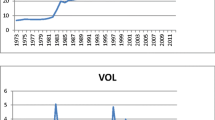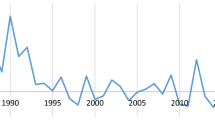Abstract
Recent instability in Egypt has brought attention to the role of risk in this important economy. At the same time, there is room in the ever-expanding literature on the link between exchange-rate volatility and trade flows, particularly for individual commodities, in Egypt. This study examines 36 separate export and import industries vis-à-vis the United States, from 1994 to 2007. An application of cointegration analysis and error-correction modeling finds evidence of long-run relationships for many import and export industries, with exports increasing due to higher risk in a large proportion of cases. Although most industries, particularly in imports, are nevertheless unaffected, our results differ from other studies in the literature. An analysis of our industry-level results shows that chemical imports, and exports of industries with large trade shares, are more likely to increase than are other products or imports.

Similar content being viewed by others
Notes
See Sauer and Bohara (2001, p. 145) for classification of countries.
Two other studies have looked at Egypt’s trade flows but have not included a measure of exchange rate volatility in their model. Abu Hatab et al. (2012) examine Egypt’s trade with China, but focus on trade intensity rather than the exchange rate. They find low value in Egypt’s trade intensity index, implying that Egyptian trade with China is less than what it should be. The intra-industry trade index also happens to be low, implying that trade between the same firms in both countries is also less that what it should be. Once the comparative advantage index is calculated for each of the ten single digit industries that are traded between two countries, they show that Egypt has strong comparative advantage in mineral fuel (SITC3), crude materials (SITC2), manufactured goods (SITC6) and food and live animals (SITC0). This comparative advantage, however, has been declining for some goods. China is shown to have comparative advantage in manufactured goods (SITC6 and SITC8), and machinery and transport equipments (SITC7). Kulkarni (1996) investigates the J-curve and finds evidence of the J-curve effect and shows that the Marshall-Lerner condition is met for aggregate Egyptian, as well as Ghanian, trade. Finally, Bahmani-Oskooee and Hosny (2013) estimate Egypt’s industry-level trade flows for 59 industries and find that the Marshall–Lerner condition (whereby a devaluation will help a country’s trade balance only if the sum of its trade elasticities exceeds one) holds in 39 cases.
For a detailed step by step construction of ECM see Bahmani-Oskooee and Tanku (2008).
For graphical presentation of these tests see Bahmani-Oskooee et al. (2005) and for some other applications of the ARDL approach see For other applications of this approach see Halicioglu (2007), Narayan et al. (2007), Tang (2007), Mohammadi et al. (2008), Wong and Tang (2008), Chen and Chen (2012), and Wong (2013).
References
Abu Hatab AR, Shoumann NA, Xuexi H (2012) Exploring Egypt–China bilateral trade: dynamics and prospects. J Econ Stud 39(3):314–326
Achy L, Sekkat K (2003) The European single currency and MENA’s exports to Europe. Rev Dev Econ 7(4):563–582
Bahmani-Oskooee M, Hegerty SW (2007) Exchange rate volatility and trade flows: a review article. J Econ Stud 34:211–255
Bahmani-Oskooee M, Hegerty SW (2009a) The effects of exchange-rate volatility on commodity trade between the US and Mexico. South Econ J 79:1019–1044
Bahmani-Oskooee M, Hegerty SW (2009b) Exchange-rate risk and US-Japan trade: evidence from industry level data. J Jpn Int Econ 22(4):518–534
Bahmani-Oskooee M, Hegerty SW (2012) Measures of uncertainty in economics. In: Simmons PE, Jordan ST (eds) Economics of innovation, incentives and uncertainty. Nova Science Publishers, New York
Bahmani-Oskooee M, Hosny AS (2013) Long-run price elasticities and the Marshall–Lerner condition: evidence from Egypt–EU commodity trade. Eur J Dev Res 25:695–713
Bahmani-Oskooee M, Tanku A (2008) The black market exchange rate versus the official rate in testing PPP: which rate fosters the adjustment process. Econ Lett 99:40–43
Bahmani-Oskooee M, Economidou C, Goswami GG (2005) How sensitive are Britain’s inpayments and outpayments to the value of the British pound. J Econ Stud 32:455–467
Bahmani-Oskooee M, Bolhasani M, Hegerty SW (2012a) Exchange-rate volatility and industry trade between Canada and Mexico. J Int Trade Econ Dev 21(3):391–410
Bahmani-Oskooee M, Harvey H, Hegerty SW (2012b) Exchange-rate volatility and industry trade between the US and Korea. J Econ Dev 37(1):1–25
Bahmani-Oskooee M, Harvey H, Hegerty SW (2012c) Exchange-rate volatility and Sweden’s trade with Germany: evidence from industry data. In: Pedersen ML, Christoffersen J (eds) Nordic countries: economic, political and social issues. Nova Science Publishers, New York
Bahmani-Oskooee M, Harvey H, Hegerty SW (2013) The effects of exchange-rate volatility on commodity trade between the US and Brazil. N Am J Econ Financ 25:70–93
Chen S-W, Chen T-C (2012) Untangling the non-linear causal nexus between exchange rates and stock prices: new evidence from the OECD countries. J Econ Stud 39:231–259
Chowdhury Abdur R (1993) Does exchange rate volatility depress trade flows? Evidence from error-correction models. Rev Econ Stat 75:700–706
Clark PB (1973) Uncertainty, exchange risk, and the level of international trade. West Econ J 6:302–313
Cushman David O (1992) The effects of real exchange rate risk on international trade. J Int Econ 15:45–63
Engle RF, Granger CWJ (1987) Co-integration and error-correction: representation, estimation and testing. Econometrica 55:1251–1276
Giorgioni G, Thompson JL (2002) Which volatility? The case of the exports of wheat. Appl Econ Lett 9(4):681–684
Halicioglu F (2007) The J-curve dynamics of Turkish bilateral trade: a cointegration approach. J Econ Stud 34:103–119
Kenen Peter B, Rodrik Dani (1986) Measuring and analyzing the effects of short-term volatility in real exchange rates. Rev Econ Stat 68:311–315
Kulkarni KG (1996) The J-curve hypothesis and currency devaluation: cases of Egypt and Ghana. J Appl Bus Res 12(2):1–8
McKenzie MD (1999) The impact of exchange rate volatility on international trade flows. J Econ Surv 13:71–104
Mohammadi H, Cak M, Cak D (2008) Wagner’s hypothesis: new evidence from Turkey using the bounds testing approach. J Econ Stud 35:94–106
Narayan PK, Narayan S, Prasad BC, Prasad A (2007) Export-led growth hypothesis: evidence from Papua New Guinea and Fiji. J Econ Stud 34:341–351
Perée Eric, Stenherr Alfred (1989) Exchange rate uncertainty and foreign trade. Eur Econ Rev 33:1241–1264
Pesaran MH, Shin Y, Smith RJ (2001) Bounds testing approaches to the analysis of level relationships. J Appl Econ 16:289–326
Sauer C, Bohara AK (2001) Exchange rate volatility and exports: regional differences between developing and industrialized countries. Rev Int Econ 9(1):133–152
Tang TC (2007) Money demand function for Southeast Asian countries: an empirical view from expenditure components. J Econ Stud 34:476–496
Wong HT (2013) Real exchange rate misalignment and economic growth in Malaysia. J Econ Stud 40:298–313
Wong KN, Tang TC (2008) The effects of exchange rate variability on Malaysia’s disaggregated electrical exports. J Econ Stud 35:154–169
Author information
Authors and Affiliations
Corresponding author
Rights and permissions
About this article
Cite this article
Bahmani-Oskooee, M., Hegerty, S.W. & Hosny, A.S. The effects of exchange-rate volatility on industry trade between the US and Egypt. Econ Change Restruct 48, 93–117 (2015). https://doi.org/10.1007/s10644-014-9153-3
Received:
Accepted:
Published:
Issue Date:
DOI: https://doi.org/10.1007/s10644-014-9153-3




